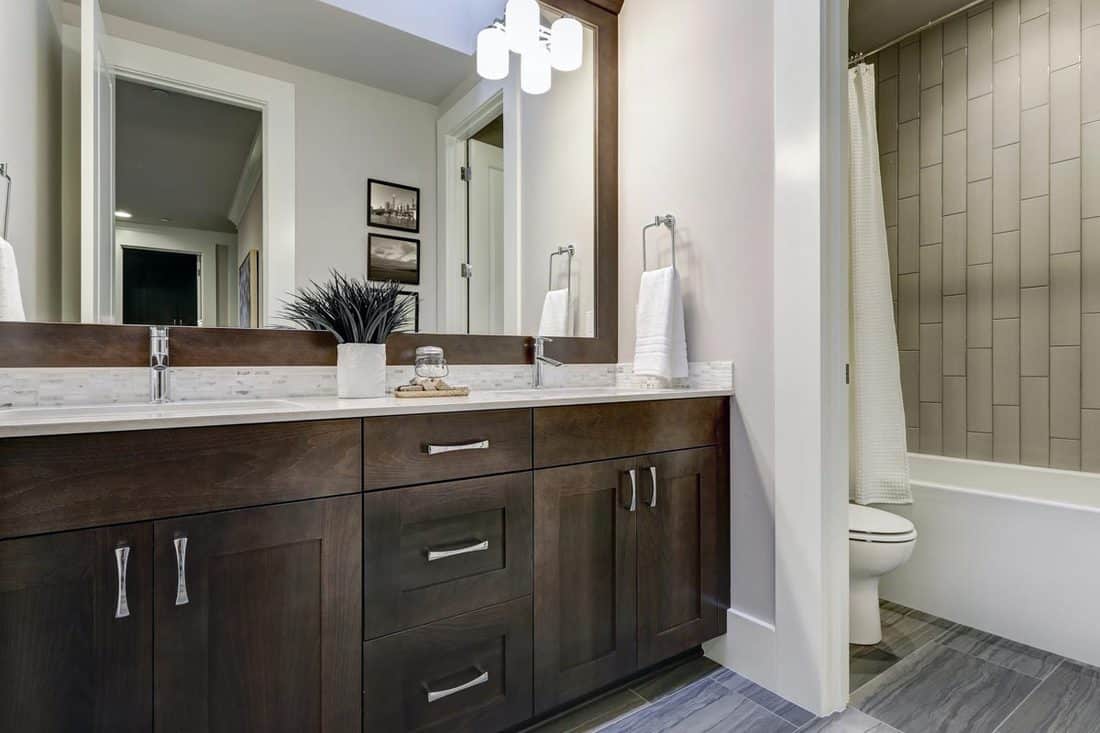Understanding Transitional Bathroom Vanity Cabinets

Transitional bathroom vanities strike a harmonious balance between classic and contemporary styles, offering a timeless appeal that complements a wide range of bathroom designs. They seamlessly blend traditional elements with modern touches, creating a sophisticated and versatile look that never goes out of style.
Key Features and Characteristics
Transitional bathroom vanities are characterized by their ability to bridge the gap between traditional and modern aesthetics. They often incorporate elements from both styles, resulting in a unique and balanced design.
- Classic Lines and Shapes: Transitional vanities typically feature clean lines, symmetrical designs, and traditional shapes, such as rectangular or oval basins. These elements evoke a sense of timelessness and elegance, reminiscent of classic design principles.
- Modern Touches: While maintaining a classic foundation, transitional vanities often incorporate modern accents. This could include sleek hardware, minimalist detailing, or contemporary materials like stainless steel or glass. These modern elements add a touch of sophistication and a sense of current design trends.
- Versatile Materials: Transitional vanities can be crafted from a variety of materials, including natural wood, painted finishes, stone countertops, and metal accents. This versatility allows for customization and personalization, enabling homeowners to create a vanity that complements their unique style and preferences.
- Functionality and Storage: Transitional vanities prioritize both functionality and storage. They often feature ample drawer and cabinet space to accommodate bathroom essentials, while maintaining a sleek and streamlined aesthetic.
Advantages and Considerations

Transitional bathroom vanities offer a blend of classic and contemporary design elements, making them a popular choice for homeowners seeking a timeless yet stylish bathroom aesthetic. These vanities are versatile and adaptable, seamlessly integrating into a wide range of bathroom designs. However, it’s important to weigh the advantages and potential limitations before making a decision.
Advantages of Transitional Bathroom Vanities
Transitional bathroom vanities offer a range of advantages that make them a compelling choice for many homeowners. Here are some key benefits:
- Timeless Appeal: Transitional design elements, such as simple lines, elegant curves, and traditional accents, create a timeless aesthetic that endures changing trends. This means your bathroom vanity will remain stylish for years to come, avoiding the need for frequent updates.
- Versatility: Transitional vanities seamlessly blend with a variety of bathroom styles, from traditional to contemporary. They can be paired with a range of finishes, materials, and accessories to create a cohesive and personalized look.
- Wide Range of Options: Transitional bathroom vanities are available in a wide array of styles, sizes, and materials, allowing you to find the perfect fit for your bathroom and budget. From sleek and modern designs to more traditional styles, there’s a transitional vanity for every taste.
- Enhanced Functionality: Transitional vanities often feature practical design elements, such as ample storage space, convenient drawers, and durable construction, ensuring both beauty and functionality in your bathroom.
Considerations for Transitional Bathroom Vanities, Transitional bathroom vanity cabinets
While transitional bathroom vanities offer many advantages, there are a few considerations to keep in mind:
- Style Compatibility: While transitional vanities are versatile, they may not be the best choice for bathrooms with a very strong or specific style, such as a purely modern or rustic design. It’s important to ensure the vanity complements the overall bathroom aesthetic.
- Material Selection: The materials used in transitional vanities can vary widely, from natural wood to engineered wood, metal, and stone. Choosing the right material is crucial for durability, maintenance, and aesthetic appeal. Natural wood, for instance, requires more maintenance than engineered wood but offers a unique warmth and character.
- Budget: Transitional bathroom vanities can range in price depending on the materials, craftsmanship, and features. It’s important to set a budget and explore options within that range to find a vanity that meets both your style and financial needs.
Choosing the Right Transitional Bathroom Vanity

The perfect transitional bathroom vanity is a harmonious blend of style and functionality. It’s the focal point of your bathroom, so choosing the right one is crucial. You’ll want to consider your space, your style, and your budget.
Vanity Size and Dimensions
The size of your bathroom vanity will determine the overall layout and functionality of your space. A vanity that is too small will be cramped and difficult to use, while a vanity that is too large will overwhelm the room. Measure your bathroom carefully to ensure that you have enough space for the vanity you choose. Consider the following:
* Width: The width of the vanity should be wide enough to accommodate your sink, faucets, and any storage you need. For a standard double sink vanity, you’ll need a minimum of 60 inches in width.
* Depth: The depth of the vanity should be deep enough to provide adequate counter space and storage. A standard depth is 21 inches.
* Height: The height of the vanity should be comfortable for you to use. The standard height for a vanity is 34 inches.
Countertop Materials and Finishes
The countertop is a prominent feature of your vanity, so choosing the right material and finish is important.
* Popular Countertop Materials:
* Quartz: A durable and low-maintenance option that comes in a wide range of colors and patterns.
* Granite: A natural stone known for its durability and unique veining.
* Marble: A luxurious option that is susceptible to stains and etching, requiring careful maintenance.
* Laminate: A budget-friendly option that is available in a wide variety of styles.
* Finishes:
* Polished: A high-gloss finish that is reflective and easy to clean.
* Matte: A non-reflective finish that is less susceptible to fingerprints and scratches.
* Honed: A satin finish that is smooth and subtle.
Popular Transitional Bathroom Vanity Styles
| Vanity Style | Material | Finish | Features |
|---|---|---|---|
| Double Sink Vanity with Shaker Doors | Oak | Stained | Two sinks, ample storage, simple shaker-style doors |
| Single Sink Vanity with Raised Panel Doors | Cherry | Painted | Elegant raised panel doors, single sink, open shelving |
| Floating Vanity with Drawer Storage | Walnut | Natural | Modern floating design, drawers for storage, minimal footprint |
| Vanity with Integrated Sink | Maple | White | Seamless look with integrated sink, sleek design |
| Vanity with Wrought Iron Hardware | Pine | Distressed | Rustic charm with wrought iron hardware, open shelving |
Transitional bathroom vanity cabinets offer a blend of classic and contemporary styles, making them a popular choice for modern homes. If you’re looking for a stylish and functional bathroom solution, consider the oaks on lonsdale 2 bedroom apartment , which boasts beautifully appointed bathrooms that might be a perfect fit for transitional vanity cabinets.
These cabinets can add a touch of sophistication and elegance to your bathroom, while also providing ample storage space for all your essentials.
Transitional bathroom vanity cabinets offer a balanced blend of traditional and contemporary styles, often featuring clean lines with subtle embellishments. For a more streamlined look, consider incorporating a modern wall mounted bathroom cabinet into your transitional bathroom design. This can provide a sleek focal point while maintaining the overall aesthetic of the space.
When choosing a modern wall-mounted cabinet for a transitional bathroom, opt for a design that complements the existing vanity and fixtures, ensuring a cohesive and stylish outcome.
